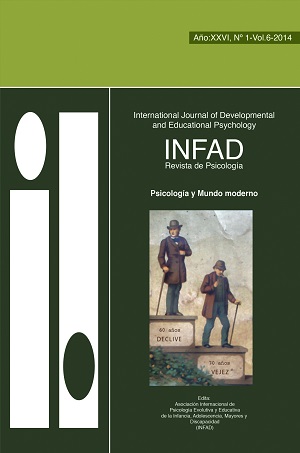Fluidez y exactitud en la copia de letras del alfabeto (manuscrita vs. cursiva): un estudio transversal
##plugins.themes.bootstrap3.article.main##
Resum
La escritura evoluciona con el paso del tiempo. El tipo de letra que los niños comienzan a aprender depende del currículo de su país y la política educativa. Hay dos tipos principales de letra: manuscrita y cursiva. Existe un debate sobre qué tipo de letra sería mejor utilizar para comenzar la enseñanza de la escritura, pero no se ha llegado a un consenso. Esta investigación analiza la escritura con ambos tipos de letra. Nuestro objetivo ha sido averiguar si existen diferencias en la exactitud y fluidez cuando los niños copian el alfabeto utilizando diferentes tipos de letras (manuscrita vs. cursiva), y si estas diferencias están mediatizadas por el curso (1º, 2º y 3º). Para ello se administraron algunos subtests de la prueba denominada Early Grade Writing Assessment (EGWA) (Jiménez, 2012) a una muestra de niños de 1º, 2º y 3º de Educación Primaria.
##plugins.themes.bootstrap3.article.details##
Secció
Aquellos autores/as que tengan publicaciones con esta revista, aceptan los términos siguientes:
- Los autores/as conservarán sus derechos de autor y garantizarán a la revista el derecho de primera publicación de su obra, el cuál estará simultáneamente sujeto a la Licencia de reconocimiento de Creative Commons que permite a terceros copiar y redistribuir el material en cualquier medio o formato bajo los siguientes términos: —se debe dar crédito de manera adecuada, brindar un enlace a la licencia, e indicar si se han realizado cambios. Puede hacerlo en cualquier forma razonable, pero no de forma tal que sugiera que usted o su uso tienen el apoyo de la licenciante (Atribución); — no se puede hacer uso del material con propósitos comerciales (No Comercial); — si se remezcla, transforma o crea a partir del material, no podrá distribuirse el material modificado (Sin Derivadas).
- Los autores/as podrán adoptar otros acuerdos de licencia no exclusiva de distribución de la versión de la obra publicada (p. ej.: depositarla en un archivo telemático institucional o publicarla en un volumen monográfico) siempre que se indique la publicación inicial en esta revista.
- Se permite y recomienda a los autores/as difundir su obra a través de Internet (p. ej.: en archivos telemáticos institucionales o en su página web) antes y durante el proceso de envío, lo cual puede producir intercambios interesantes y aumentar las citas de la obra publicada. (Véase El efecto del acceso abierto).

Este obra está bajo una licencia de Creative Commons Reconocimiento-NoComercial-SinObraDerivada 4.0 Internacional.
Com citar
Referències
Bell, M. E. (1968). Manuscript writing after the primary grades Education.
Berninger, V. W., Abbott, R. D., Jones, J., Wolf, B. J., Gould, L., Anderson-Youngstrom, M., & Apel, K. (2006). Early Development of Language by Hand: Composing, Reading, Listening, and Speaking Connections; Three Letter-Writing Modes; and Fast Mapping in Spelling. Developmental Neuropsychology, 29(1), 61-92.
Berninger, V. y Wolf, B. (2009). Teaching Students with Dyslexia and Dysgraphia. Lessons from Teaching and Science. Baltimore, London, Sydney: Paul H. Brookes.
Blote, A., & Hamstra-Bletz, L. (1991). A longitudinal study on the structure of handwriting. Perceptual Motor Skills, 72, 983-994.
Cox, A.R. (1992). Foundations for literacy: Structures and techniques for multisensory teaching of basic written English language skills. Cambridge: Educators Publishing Service.
Cutler, L., & Graham, S. (2008). Primary grade writing instruction: A national survey. Journal Of Educational Psychology, 100(4), 907-919.
Graham, S., Struck, M., Santoro, J., & Berninger, V. W. (2006). Dimensions of Good and Poor Handwriting Legibility in First and Second Graders: Motor Programs, Visual–Spatial Arrangement, and Letter Formation Parameter Setting. Developmental Neuropsychology, 29(1), 43-60.
Graham, S., Weintraub, N., & Berninger, V. W. (1998). The relationship between handwriting style and speed and.. Journal Of Educational Research, 91(5), 290.
Graham, S., Berninger, V. W., Abbott, R. D., Abbott, S. P., & Whitaker, D. (1997) Role of mechanics in composing of elementary school students: A new methodological approach. Journal of Educational Psychology, 89, 170-182.
Gray, W. H. (1930). An experimental comparison of the movements in manuscript writing and cursive writing. Journal of Educational Psychology, 21(4), 259-272.
Hildreth, G. (1945). Comparative speed of joined and unjoined writing strokes. Journal of Educational Psychology, 36(2), 91-102.
Jiménez, J.E. (2013) Informe sobre las Prácticas de Enseñanza de la Escritura en los Primeros Niveles de Educación Primaria: un estudio realizado en la Comunidad Autónoma de Canarias. Unpublished manuscript.
Jiménez., J.E. (2012). Early Grade Writing Asssessment (EGWA): A report and a model instrument. París: United Nations, Educational Scientific and Cultural Organization. Unpublished manuscript.
Lehaman, C. (1980). Teaching and learning the craft of handwriting. The Education Digest, 45, 50.
Medwell, J. y Wray, D. (2007). Handwriting: What do we know and what do we need to know? Literacy, 41(1), 10-15.
Paillard F, Sterkers G, Vaquero C. (1990) Transcriptional and post-transcriptional regulation of TcR, CD4 and CD8 gene expression during activation of normal human T lymphocytes. EMBO J., 9(6): 1867–1872.
Parush, S., Lifshitz, N., Yachman, A., & Weintraub, N. (2010). Relationships between handwriting components and underlying perceptual-motor functions among students during copying and dictation tasks. Occupation, Participation and Health, 30, 39-48.
Sovik, N., & Arntzen, 0. (1991). A developmental study of the relation between the movement patterns in letter combinations (words) and writing. In J. Wann, A. Wing & N. Sovik (Eds). Development of graphic skills: Research, perspectives, and educationd implications (pp. 77-89). London: Academic Press.
Trap-Porter, J., Cooper, J.O., Hill, D.S., Swisher, K., & Lanunziata, L.J. (1984). D’Nealian and Zaner-Bloser manuscript alphabets and initial transition to cursive handwriting. Journal of Educational Research, 77, 343-345.
Trap-Porter, J., Gladden, M.A., Hill, D.S., & Cooper, J.O. (1983). Space size and accuracy of second and third grade students’ cursive handwriting. Journal of Educational Research, 76, 231-234.
Ziviani, J., & Elkins, J. (1984). An evaluation of handwriting performance. Educational Review, 36,251-261.

